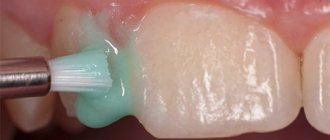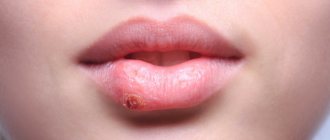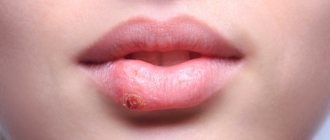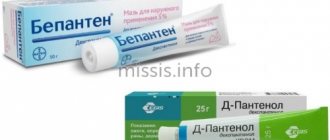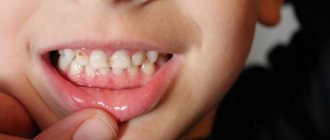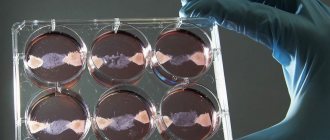Home | Can teeth straighten themselves?
The formation of dental buds occurs in the prenatal period at the earliest stages of fetal development. This process is influenced by the mother’s health and lifestyle, and genetic factors. After the birth of a child, a balanced diet and type of feeding (artificial or breastfeeding) are of great importance. With the eruption of the first tooth, it is necessary to pay attention to oral hygiene. We can talk about the final formation of the bite at the age of 12-14 years. An incorrect bite can form due to a number of reasons:
- Abnormal development of the jaws – macrogeny (enlargement of the jaw bone), microgeny (underdevelopment, reduction of the jaw bone);
- Violation of the timing of teeth change;
- Premature removal of baby teeth;
- Inadequate nasal breathing;
- Bad habits: thumb sucking, pacifiers, biting pencils and other objects;
- Unfavorable heredity.
Why do children and adults have crooked teeth?
To the question “ Why do teeth grow crooked?” “There is no clear answer. There are several factors that lead to such problems, namely:
- Genetics. About 15-20% of cases of crooked teeth are associated with hereditary factors.
- Features of nutrition and feeding in the early period of growth. Thanks to breastfeeding and proper nutrition, the child trains the jaw muscles and forms the correct position and size of the gums. When he does not have such training, the muscles remain weak.
- Chronic diseases of the nasopharynx. They lead to constant mouth breathing, which negatively affects the teeth.
- Early loss of baby teeth, which causes the main ones to grow outside the dentition and become crooked.
- Bad habits, especially in young children. Sucking a pacifier, sleeping with a finger in your mouth, and the habit of biting your nails have an extremely negative impact on soft bones. Adults are affected by the habit of chewing pencils and pens - this usually bends the front incisors.
- Loss of one or more elements of the dentition. It especially affects the adult bite, which changes slowly. the curvature of the teeth will not be visually noticeable, but will still have a negative impact on the bite.
- The eruption of wisdom teeth can also disrupt the position of one or more molars and incisors. Lack of space in the jaw leads to crooked teeth and then crooked teeth.
The causes of crooked teeth can also be individual, for example, various genetic diseases often contribute to this. Your doctor will help you determine the real basis of the problem.
If your child's permanent teeth grow unevenly
Often, even a correct bite and straight baby teeth are not a guarantee that a child’s uneven molars will not “come out.” Most permanent teeth erupt unevenly (and this is normal), but as they “come out” they unfold. As the child's jaw grows, there is more room for new teeth, so they gradually take on the correct position. But it also happens that the jaw increases in size much more slowly than the teeth. As a result, the latter do not have enough free space, which is why they continue to grow unevenly or begin to “crawl” on top of each other, and sometimes even line up in two rows. A similar situation is also possible if a child has a baby tooth removed ahead of time.
What are crooked teeth?
A variety of teeth can be crooked, from baby teeth to permanent teeth. It is very important to correct all bite defects in a timely manner, otherwise you can lead to serious changes in the dentition, which will take longer and more difficult to treat.
Dairy
Preventing the curvature of baby teeth is not so difficult - it is enough to see a doctor from an early age. Experienced orthodontists can predict possible curvature even before eruption, let alone 2-3 years. The doctor will help determine whether everything is fine with the child and whether his baby teeth are within normal limits.
You need to understand that a baby’s first teeth almost always grow a little crooked. There is no need to be afraid of this, everything will level out after the final eruption. But if this does not happen, then it’s time to make an appointment with a doctor. It is also normal if your child has small gaps between his teeth.
Small, even spaces between a small child’s teeth are normal.
After complete eruption and before the bite begins to change, it is very important to correct all problems, because crooked baby teeth in children almost always lead to the appearance of crooked permanent teeth. The tooth does not grow in a vacuum; it is guided by the position of its neighbors. If their shape is initially incorrect, new permanent molars, incisors and canines will also not be able to erupt correctly.
Permanent
Curvature of permanent teeth is a consequence of insufficient care of parents when changing the bite or other external factors. How even the permanent teeth will be depends greatly on the condition of the milk teeth. That is why it is better to start treatment as early as possible. This way you get an additional bonus: wearing plates on baby teeth does not damage their enamel, and permanent teeth are not exposed to unnecessary damage.
Interestingly, some adults deliberately crook their teeth to get a “cute baby smile.” This is especially popular in Japan. The appearance really takes on a zest, but such experiments are very harmful and threaten to leave fashionistas without teeth by the age of thirty.
Special crooked teeth look cute, but cause serious damage
Wisdom teeth
Crooked wisdom teeth appear in approximately 40% of cases. Most often, teething begins between the ages of 14 and 25 and can create many problems if a person has a naturally narrow jaw and there is no room for an “eight” in it. In this case, the doctor does not correct crooked wisdom teeth
Are uneven baby teeth a problem?
When a baby's first teeth begin to grow, they are usually straight and close together. As the child grows, his jaw also increases in size, causing the teeth to “diverge.” Normally, the spaces between the teeth should be even. If the first teeth are uneven and unequally spaced, this may indicate that the jaw is developing asymmetrically. Does your child have uneven baby teeth? Don't think that they will become smoother with age. Instead, take your child to the pediatric dentist. Timely diagnosis and treatment will help avoid serious consequences, such as the appearance of uneven molars.
Causes of curvature over time
As mentioned, crooked teeth in adults can develop over time. Usually, habits or other external factors negatively affect the dentition. The most popular reasons for the appearance of crooked permanent teeth in adult patients:
- Long-term bad habits. You should not bite your nails, tear off threads and fabric with your teeth, crack nuts, etc. It may seem that all this does not have a significant effect, but in fact, over time, the teeth change position, succumbing to regular exposure.
- Loss of one element in a row. The remaining teeth move apart, trying to fill the void, and may well become crooked.
- Tooth wear, jaw osteoporosis, gum recession and other aging problems. They don't necessarily cause crooked teeth, but they can be one of the reasons.
Myth 2. You can straighten the position of the tooth and/or bite yourself and without the intervention of an orthodontist
Oh yeah! And such things as “straighten your bite at home” can be heard when communicating with patients (most often after an unsuccessful attempt to straighten a tooth at home), or you can even find “valuable advice” on the topic of “straightening teeth at home” on the Internet.
Correct your bite or dental defect with invisible aligners Find out what it is
Why is it necessary to correct crooked teeth? When is it more effective to correct?
Of course, it is most effective to correct crooked teeth in children. Before changing the bite, it is very easy to influence the dentition - milk teeth, although strong, are relatively easy to influence. But the older you get, the more difficult the dentist’s work is. But don’t think that after 25 everything is lost: modern orthodontic treatment helps to cope with crooked teeth at any age.
Reasons why it is important to correct a crooked tooth :
- Elements of the dentition that have defects are more often susceptible to caries, and it is much more difficult to treat due to their incorrect position;
- The presence of crooked teeth almost always means an incorrect bite and overload of the joint, as well as the main molars (they wear out faster).
- Displaced elements are a common cause of joint hypertonicity, which leads to bruxism.
- Bite pathologies lead to breathing problems and improper chewing of food, which can cause disease in the nasopharynx or gastrointestinal tract.
- Often, the curvature of the teeth leads to a violation of the proportionality of the face.
Treatment of crooked teeth changes a person's appearance and makes him more attractive.
What is dangerous about malocclusion?
Violations of occlusion entail diverse consequences from gastrointestinal disorders to psychological complexes. If you are already thinking about correcting your bite, you are most likely familiar with its consequences firsthand. It is also worth noting that malocclusion often provokes premature tooth decay, as it is often the cause of pathological abrasion of teeth, the development of caries and periodontitis. In addition, the pathology can lead to overload of the temporomandibular joint, when the patient replaces clicks and crunches when opening and closing the mouth.
What could be the consequences?
It is impossible to ignore an incorrect bite: the consequences turn out to be much deeper than just crooked teeth in the photo and inconvenience when chewing. Crooked teeth are difficult to clean, so bacteria accumulate among them, causing chronic inflammation. It can spread to the mucous membrane and even to the bone. Another disease of this kind is chronic stomatitis. It appears due to the fact that the tooth constantly damages the mucous membrane in one place.
An incorrect bite leads to poor digestion of food, which can lead to gastritis or even an ulcer. This is also facilitated by the entry of bacteria into the intestinal tract. Along with gastrointestinal diseases, skin diseases appear, hair becomes more brittle, and other organs that do not receive sufficient nutrition also suffer.
The uneven position of teeth also provokes premature aging of the facial skin and the appearance of deep expression wrinkles. And too much stress on the masticatory muscle is transferred to the joint, which quickly wears out, begins to click, crunch, and then hurt. Unpleasant sensations almost always go to your head, causing something like a migraine.
Causes of crooked teeth
There are quite a few factors that determine the curvature of milk units. Sometimes parents are to blame for the violation, because they do not allow their grown-up child to chew solid food on their own for too long or ignore the symptoms of calcium deficiency. It also happens that the curvature is caused by the individual characteristics of the baby’s body. This is what the most common causes of curvature look like:
- hereditary predisposition;
- chronic pathologies of the nasopharynx, forcing the baby to constantly breathe through the mouth;
- speech therapy disorders not corrected in a timely manner;
- too short frenulum, anatomically large tongue;
- bad habit of sucking fingers, gnawing foreign objects;
- Bottle feeding your baby once he or she reaches one year of age.
All these are factors that contribute to the curvature of baby teeth. If the violation is obvious, there is no need to panic. The doctor will select a method that will quickly straighten the teeth. Moreover, the sooner treatment is started, the better. Therefore, there is no need to delay seeking dental care.
How to prevent pathology
prevent your child from developing crooked teeth by regularly visiting the orthodontist's office. Even if your baby has a genetic predisposition to certain diseases, dealing with them at an early stage is much easier.
Adults can avoid the appearance of upper and lower crooked teeth if they do not delay the installation of implants after the loss of one of the molars, and also remove their wisdom teeth in a timely manner. In addition, it is necessary to get rid of the habit of gnawing on durable objects, not to knock your teeth against each other and not to clench your jaw during emotional stress.
When should you go to the dentist?
What to do if a tooth grows unevenly? The only correct answer is to seek help from specialists at a dental clinic where children's doctors are seen. You should be examined at least twice annually to monitor the dynamics of the process. You should go to the dentist if your child has unevenly set teeth. After the conversation and diagnostic measures, the dentist will be able to give an accurate answer. Treatment may require special devices that should be worn for a long time. Mouthguards, braces, trainers and other devices for changing malocclusion will help cope with the problem.
Conclusions. Expert advice
Crooked teeth can appear for various reasons, ranging from heredity to bad habits. Both primary and permanent elements of the dentition grow incorrectly, and the “eights” of wisdom are almost always not formed correctly enough. Tooth curvature is not only a childhood disease. Trauma, age-related changes, or even a love of chewing pencils can cause problem teeth in adults.
It doesn’t matter whether you have one or several crooked incisors, you definitely need treatment. The first thing you need to do is contact a therapist, and then an orthodontist, who will decide what to do with crooked teeth in your situation. There are quite a few treatment methods, each with its own pros and cons. Sometimes the doctor decides to combine several methods, for example, installing braces and prescribing wearing a trainer. In especially severe cases, surgery is used.
Lack of treatment is very dangerous, because when teeth are crooked, the load during chewing is distributed unevenly. The longer the patient waits, the more severely some elements of the dentition wear out, leaving others without work. This leads to premature loss of molars and incisors. This is followed by bone depletion and expensive implant surgery, if it is possible at all. Avoiding such a development of events is not so difficult: you need to visit the orthodontist in time and correct the bite.
Myths about teeth
Myth 1. Whitening is harmful - it damages the enamel...
No. The color of a tooth is given by dentin - the main tissue of the tooth, which is located under the enamel. To reach the dentin and lighten it, a whitening gel is applied to the teeth and activated by the light of a special lamp, as a result of which the gel breaks down into water and oxygen. Oxygen penetrates dentin and discolors pigments, but does not change the structure of dentin. And calcium phosphate, which is part of whitening systems, helps improve the structure of tooth enamel. The whitening procedure ends with remineralizing therapy, which reliably protects the enamel surface. We use only advanced whitening technologies - the ZOOM2! whitening system; this technique allows you to lighten your teeth by an average of 8 shades (and sometimes 10-12) in just one visit. Remember: whitening is safe if carried out under the supervision of an experienced, certified and experienced doctor, using certified equipment using original whitening gel.
Myth 2. After whitening, cracks will appear on your teeth...
No. During professional whitening, cracks in teeth cannot appear, especially since modern systems for professional in-office whitening Zoom2 contain a special component (amorphous calcium phosphate) that can penetrate the thickness of the enamel and strengthen it.
Myth 3. Teeth can be whitened with baking soda...
Yes, but you can use baking soda no more than once a week, as it can scratch the enamel. Another thing is pastes containing bicarbonate of soda. There, the soda particles are much smaller in size and do not injure the enamel as much. Such pastes can be used daily, but not longer than a month, then you need to take a break.
Myth 4. Be sure to brush your teeth 2 times a day...
Yes. You need to brush your teeth at least 2 times a day, and maybe more. It all depends on how quickly plaque accumulates on the teeth. Ideally, you should brush your teeth after every meal.
Myth 5. In the morning you should brush your teeth after breakfast...
Yes, you need to brush your teeth after eating. But in the morning it is preferable to do this before breakfast (to remove accumulated plaque overnight and for yourself personally - to feel freshness) and always after breakfast - to cleanse the oral cavity of food debris.
Myth 6. Overbite can only be corrected in childhood...
No. You can correct your bite at almost any age. But there is a severe pathology in which changes have occurred not only in the position of the teeth, but also in the jaw bones. In this case, there are certain age limits.
Myth 7. It is necessary to treat a diseased tooth “to the last” before removing it...
Yes. Tooth extraction leads to gradual displacement of adjacent teeth, which affects the appearance and can create serious problems with chewing. Displacement will definitely occur, because each of the teeth in the dental system has its own function and load. Therefore, it is better to treat the tooth “to the last.” But, if removal cannot be avoided, it is better to immediately place an implant.
At the same time, the removal of a wisdom tooth, unlike the removal of other teeth, does not threaten a significant curvature of the bite that occurs when neighboring teeth move to the place of the removed one.
Myth 8. Healthy enamel is white enamel...
No. There are no absolutely white teeth in nature. Their color depends on dentin and is inherited. It is believed that the strongest tooth tissues are those whose color is yellowish.
Myth 9. Caries occurs from sweets...
And not only. Caries appears as a result of the activity of microbes that secrete acids that dissolve the enamel. The more remains of ANY food in your mouth, the more food for germs. We brush our teeth after every meal, but we forget that we need to do the same after eating caramel. But chocolate is even useful, because the substances contained in cocoa beans protect teeth from caries due to their antimicrobial effect. But everything must be done in moderation. Dentists recommend drinking Pepsi and Coca-Cola through a straw, because it reduces the contact of the liquid that spoils the enamel with the front teeth by almost 70%, and with the molars by 30-50%.
Myth 10. Floss and mouthwash are essential for teeth...
Almost right. Balms and rinses are additional hygiene products and are used as desired. They contain substances that prevent bacteria from attaching to the tooth surface. But dental floss is one of the BASIC hygiene products that you must use.
Myth 11. You should use chewing gum after eating...
Can. But no more than 10 minutes. After eating, the acid-base balance in the mouth changes, which contributes to the development of caries. Balance can be restored by chewing gum. But you should not chew it for a long time, since the chewing process stimulates the production of gastric juice. But since it doesn’t arrive, the stomach has to “digest” itself and its mucous membrane suffers.
Myth 12. It is not necessary to treat baby teeth - they will fall out anyway...
Wrong. You should definitely contact a pediatric dentist. Baby teeth fall out as a result of physiological resorption of their roots. Between them all this time there are permanent teeth, which erupt in place of milk teeth. If left untreated, caries of a baby tooth can lead to inflammation, delayed eruption, underdevelopment of enamel, or even complete melting of the permanent tooth germ.
Myth 13. The more expensive the toothpaste, the better it is...
Not necessary. But pastes of unknown origin can “help” you acquire new microbes that are unfamiliar to our defense systems. Therefore, it is better to buy toothpaste in pharmacies.
Myth 14. You should use a different paste in the morning and evening...
Yes. In the morning you need to use highly abrasive pastes, including bleaching ones, and in the evening – pastes containing extracts of medicinal herbs.
Myth 15. You need to change the toothpaste from time to time...
Yes. Oral microbes very quickly get used to the beneficial properties of the paste (especially if the paste contains antiseptics - triclosan, chlorhexidine) and stop reacting to them.
Myth 16. If your teeth don’t hurt, you don’t need to go to the dentist...
No. You need to visit the dentist once a year. Only a dentist can see the initial stage of caries. In addition, you need to regularly remove plaque and dental deposits (tartar). Stones can be hidden under the gum and are more dangerous than supragingival deposits.
Myth 17. Gold never causes allergies...
Wrong. Gold in the mouth can be a strong allergen. Some people experience severe inflammation in areas where gold crowns come into contact with the oral mucosa. So sometimes any ordinary alloy is better than gold.
Myth 18. Implantation is very painful...
No. Modern anesthetics, for example, ultracaine, are 6-8 times stronger in their analgesic effect than novocaine. Almost no clinic in the city no longer works with Novocaine. In the absence of contraindications or at the request of the patient, implantation can be performed under general anesthesia (anesthesia).
Myth 19. Implants do not take root well...
No. Official statistics say that out of 100 installed implants, from 2 to 4 are rejected. this is about 96-98% engraftment. By definition, there cannot be a 100% guarantee. These are not just numbers. They are backed by serious research and global experience.
Myth 20. When the nerve is removed, the tooth will definitely be destroyed...
No. After the “nerve” is removed, the tooth is fed through the suspensory ligament, therefore, the tooth does not become “dead”. And its fragility is explained by the initial tissue defect, which became the reason for the removal of the “nerve” - caries or injury. Therefore, it is important to properly restore a weakened tooth. There are international standards for dental restoration, which we follow in our Clinic: if there is a hard tissue defect of up to 1/3 of the tooth, it is possible to restore the tooth with a filling, up to 1/2 requires a ceramic inlay, and if more than 1/2 of the tooth is damaged, a crown is already necessary.
Myth 21. Wisdom teething always hurts...
Almost true. Indeed, the eruption of wisdom teeth is often accompanied by pain, because:
- the wisdom tooth does not have a milk predecessor that would prepare the conditions for its eruption;
- wisdom teeth erupt when the formation of the jaw bone tissue is completely completed, and they have to overcome significant mechanical obstacles;
- the tooth does not have enough space in the dentition, which is associated with changes in the masticatory apparatus in the process of human evolution.
Removal of abnormally growing eighth tooth
Very often, if the third molar grows abnormally, it is necessary to resort to its removal. Indications for surgery:
- Repeated cases of pericoronitis (purulent formation in the gum pocket). This problem most often occurs on the lower eights, which have not completely erupted. Pericoronitis is usually treated by removing the overhanging gum, but if the disease recurs, it is recommended to remove the offending tooth.
- The upper eight grows into the cheek, constantly injuring it. To avoid the formation of ulcers and infection of the oral cavity, as well as to prevent pain, wisdom tooth removal is required.
- The development of wisdom tooth dystopia was diagnosed. The tooth grows at an incorrect angle, which can lead to inflammation of the periodontal tissues and the development of caries on the eighth and neighboring teeth.
- The wisdom tooth grows to the side and affects the ternary nerve, causing attacks of pain. Most often, this occurs when an unerupted figure eight rests on the roots of neighboring teeth. Such an anomaly can only be diagnosed using an x-ray.
The procedure for performing the manipulation may differ depending on the location of the tooth. The sequence of the procedure during surgery:
- antiseptic treatment of the operating area;
- administration of anesthetic;
- tooth extraction;
- inserting a gauze swab into the hole to eliminate bleeding.
The tampon should be removed from the wound no earlier than after 25 minutes. The tampon must be in the socket to prevent bleeding. After the operation, the dental surgeon gives recommendations that must be strictly followed.
